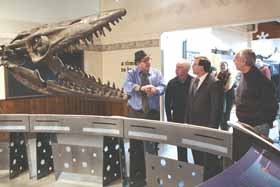Imagine a 30-foot long eel-like creature with enormous, vicious crocodile-like teeth coming after you in a sea. Now imagine that sea is covering Saskatchewan.
That story came to life December 19 at the Yorkton Western Development Museum (WDM) with the official opening of a new exhibit called Hunter of the Prairie Sea.
The travelling Royal Saskatchewan Museum (RSM) exhibit features a specimen of Tylosaurus named Omaciw (pronounced oh-matchee-oh), Cree for hunter.
Tim Tokaryk, RSM curator of paleontology describes the animal as a "hyper-predator."
"You look at the skull, it's so well-adapted to life in the sea," he said. "In the eye orbits there are bony plates behind the eye to help keep the eyeball from being punched into the skull when it's diving deep underwater. You look at the roof of the mouth, there's a set of v-shaped teeth in there to help support and grab its prey. You look at the lower jaw, it's hinged around the mid-part which means the jaw can fully grasp what it was eating. It was a serious eating machine that was around about 75 million years ago."
Susan Mandziuk, manager of the WDM was thrilled to bring the exhibit to Yorkton.
"It's very important, the normal visitations that we have, they're always looking for something new and exciting, so this is a definite complement to what we already have in the museum," she said. "We're very happy to be able to work with the Royal Saskatchewan Museum again and doing our partnership and bring in this fantastic exhibit."
The timing, she said, also could not be better.
"I think it will definitely help us in the winter months because once we're done with our school programs, there is sort of a lull and it's great that we have it over the Christmas season," she said. "I think it will be a great boost for us."
During opening remarks, Tokaryk spoke passionately about how Saskatchewan's fossil resources are an important part of the province's heritage and why the museum puts on the travelling exhibits.
"Having these displays travel the province, illustrates, at least on the first level that the Royal Saskatchewan Museum is constantly collecting new material," he said. "We don't know a lot about the past in Saskatchewan, we're really just scratching the surface and some of these fossils are so interesting that we need to share them around with the people.
"Also, to provide a sense of curiosity for people young and old that there were many ages in the past we can actually uncover in our own back yards."
Mandziuk also pointed out that the exhibit is available for school trips.
It runs until May, 2014. Check the website for holiday hours and exhibit details at www.wdm.ca.



